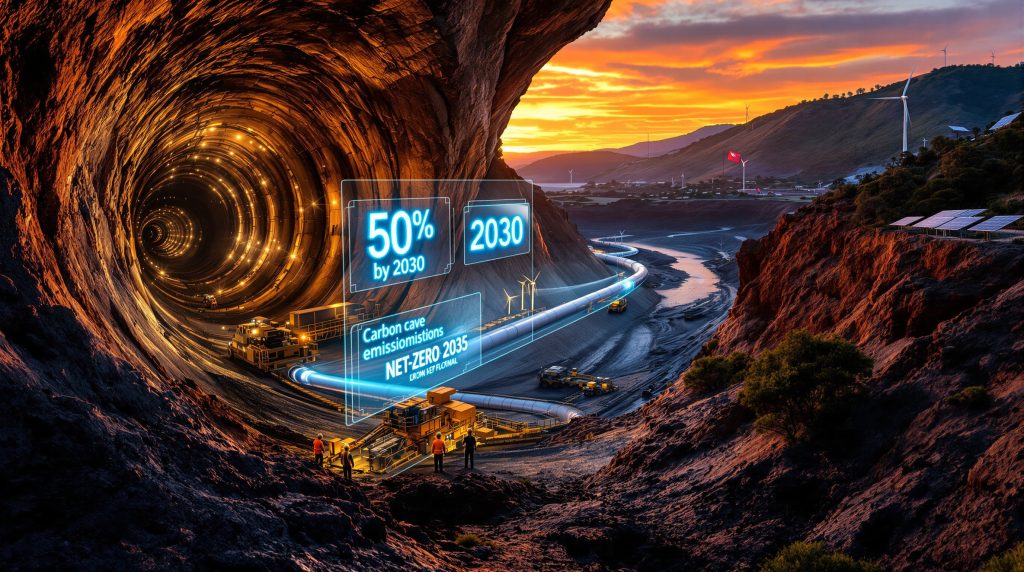Tasmania's Savage River Mine: Underground Transition for a Net-Zero Future
Tasmania's last open-cut mine at Savage River is undergoing a transformative shift to underground operations in a bold move toward sustainability and carbon neutrality. This nearly $1 billion project aims to extend the life of the 57-year-old iron ore mine while dramatically reducing its carbon footprint, with plans to achieve net-zero emissions by 2035.
As Ben Maynard, Chief Operating Officer at Grange Resources explains: "By moving underground, combined with a number of other initiatives that we have underway, we can potentially halve our carbon emissions by 2030 and be net zero by 2035."
The Scale of the Transition Project
The underground mining transition represents a significant investment and operational shift:
- Estimated investment exceeding $900 million
- Final investment decision expected by the end of 2025
- Current workforce of approximately 700 employees (450 in mining operations)
- Mining staff could decrease by approximately two-thirds by 2030
This project marks a pivotal moment for Tasmania's resources sector, as the mine evolves to meet modern environmental standards while maintaining economic viability through modern mine planning.
Why Is Savage River Mine Moving Underground?
The decision to transition from open-cut to underground operations addresses multiple challenges facing this aging but vital operation. As mining operations have progressed over decades, the open pit has grown deeper and more expansive, creating increasing operational inefficiencies.
"One of the challenges with an open pit is that as it gets larger and deeper, the waste dumps get further away, and our costs increase. We use more and more diesel," notes Maynard. "This underground transition represents a real opportunity to reduce our operating costs, set the mine up for a sustainable future and significantly reduce our carbon emissions."
Environmental and Operational Benefits
By transitioning underground, Grange Resources aims to achieve multiple strategic objectives:
- Cut carbon emissions by approximately 50% by 2030
- Achieve net-zero operations by 2035
- Reduce operating costs as the open pit becomes deeper
- Minimize the expanding footprint of waste dumps
- Decrease diesel consumption in mining operations
- Secure the long-term future of the operation
These benefits align with both corporate sustainability goals and the global mining industry's shift toward sustainable mining transformation.
The Technical Approach: Block Cave Mining
The mine will implement a specialized underground mining technique known as block cave mining, which offers significant advantages over traditional methods:
- Involves undercutting the ore body and using gravity to break up blocks
- Minimizes the need for blasting compared to conventional mining
- Reduces overall energy requirements and associated emissions
- Creates a more controlled mining environment with less surface disturbance
Block cave mining represents one of the most efficient forms of underground bulk mining, allowing for the extraction of large volumes of ore at relatively low cost compared to other underground methods.
How Will This Transition Impact Jobs and the Local Economy?
The shift to underground operations will significantly reshape the mine's workforce profile, with substantial changes expected in both the number and types of jobs available.
Workforce Implications
According to the current transition plan:
- Job numbers will increase initially during the development phase
- A gradual workforce decline will begin around 2030
- The mining staff is expected to decrease from 450 to approximately 150
- Different skill sets will be required for underground versus open-cut operations
Ben Maynard acknowledges the complexity of this transition: "At the moment … we're still working through the plans of what that would look like and it is quite a way down the track."
Regional Economic Considerations
As one of northwest Tasmania's largest employers, changes at Savage River have broader implications for the regional economy:
- The mine and Port Latta pellet plant currently employ about 700 people
- The operation is a significant economic contributor to the region
- Skills transfer opportunities may be limited as Savage River is Tasmania's only open-cut mine
- Potential exists for displaced workers to find opportunities at other mining operations
Robert Flanagan, Australian Workers' Union Assistant Branch Secretary, raises important concerns: "There are many things we don't know, and until we have detailed discussions with the company, things are not particularly clear at this time." He also notes that "Savage River was the only open-cut mine in Tasmania, and therefore some skills would not be transferable."
However, Ray Mostogl, CEO of the Tasmanian Minerals, Manufacturing and Energy Council (TMEC), offers a more optimistic perspective: "There's usually a reciprocal mine looking for people." He points to "potential restarts on the horizon for Queenstown's Mount Lyell copper mine and Zeehan's Avebury nickel mine," suggesting there would likely be mining jobs in the future.
What Makes Savage River Mine Significant to Tasmania?
Historical and Economic Importance
The Savage River mine has been a cornerstone of Tasmania's resources sector for decades:
- Operating continuously since 1967 (57 years)
- Tasmania's last remaining open-cut mining operation
- Produces iron ore that is processed into pellets for global export
- Operates a unique 85-kilometer slurry pipeline to transport ore to processing facilities
This longevity has established the mine as an integral part of Tasmania's industrial landscape and economic foundation, with its products contributing to iron ore market trends globally.
Current Operations
The mine's existing operational model involves a sophisticated process:
- Extracting magnetite (an iron ore) from open pits
- Converting the ore into slurry for pipeline transport
- Processing at the Port Latta pellet plant
- Shipping finished products to international markets
As the ABC News report notes: "Currently, ore is dug from the pit at Savage River, turned into slurry and piped about 85 kilometres to a pellet processing plant to be then shipped out across the world."
When Will Changes Begin to Take Effect?
Implementation Timeline
The transition to underground mining will follow a phased approach:
- Final investment decision expected by late 2025
- Initial increase in workforce during development phase
- Gradual reduction in open-cut operations starting around 2030
- Progressive shift to underground mining methods
- Full transition completed over multiple years
This gradual timeline allows for proper planning and adjustment for both the company and its workforce.
Stakeholder Engagement
The company is working with various stakeholders to manage the transition:
- Ongoing discussions with the Australian Workers' Union
- Coordination with the Tasmanian Minerals, Manufacturing and Energy Council
- Employee consultation regarding reallocation possibilities
- Regional economic development planning
Ray Mostogl of TMEC emphasizes: "The long-term sustainability of Grange is critical for both the organisation and the state, and that does involve fewer roles. We would look to help people get into a new career if they want to move underground."
How Does This Fit Into Broader Mining Trends?
Industry Context
The Savage River transition reflects broader trends in the global mining sector:
- Growing focus on reducing carbon footprints across the industry
- Increasing pressure to extend mine life through innovative approaches
- Rising costs associated with traditional open-cut mining at depth
- Industry-wide movement toward more sustainable mining practices
This shift aligns with international mining companies' responses to climate change concerns and increasing environmental regulations, with many operations seeking decarbonisation benefits similar to those targeted by Grange Resources.
Regional Mining Outlook
The changing landscape at Savage River comes amid potential developments elsewhere in Tasmania:
- Possible restart of Queenstown's Mount Lyell copper mine
- Potential reopening of Zeehan's Avebury nickel mine
- Opportunities for worker redeployment within the regional mining sector
- Changing skill requirements across the industry
These regional developments could help absorb some of the workforce changes expected at Savage River, creating a more resilient mining sector in Tasmania.
What Are the Environmental Implications of Underground Mining?
Carbon Reduction Strategy
The shift underground forms a central part of Grange Resources' emissions reduction strategy:
- Potential to halve carbon emissions by 2030
- Path to net-zero operations by 2035
- Significant reduction in diesel consumption
- Smaller surface footprint compared to expanding open-cut operations
These ambitious targets represent some of the most aggressive carbon reduction goals in Australia's mining sector, as detailed in the company's environmental impact statement.
Sustainable Mining Practices
The transition aligns with evolving expectations for environmental performance:
- Reduced visual impact on the landscape
- Decreased surface disturbance from waste rock disposal
- Lower noise and dust emissions
- More controlled management of mining impacts
By moving operations underground, the mine can significantly reduce its environmental footprint while continuing to contribute to the local economy, with future plans likely to include mine reclamation innovation.
FAQ: Tasmania's Savage River Mine Transition
How long has the Savage River mine been operating?
The Savage River mine has been in continuous operation since 1967, making it a 57-year-old fixture in Tasmania's mining landscape and an important part of the state's industrial heritage.
What is block cave mining?
Block cave mining is an underground mining method that involves undercutting an ore body and allowing gravity to break up the rock into manageable pieces. This technique minimizes the need for blasting and can be more cost-effective and environmentally friendly than other mining methods.
Will all jobs be lost in the transition?
While significant job reductions are expected (potentially reducing the mining workforce by about two-thirds), the transition will be gradual. The company plans to reallocate employees where possible, and the regional mining sector may offer alternative employment opportunities as other mines potentially reopen.
How does underground mining reduce carbon emissions?
Underground mining can reduce carbon emissions through decreased diesel consumption (fewer trucks traveling shorter distances), reduced surface disturbance, and more efficient ore extraction methods. The confined nature of underground operations also allows for more controlled energy management.
What happens to the existing open-cut mine?
The open-cut operations will gradually wind down starting around 2030 as underground mining ramps up. The company will likely implement rehabilitation measures for portions of the open pit that are no longer actively mined.
Environmental Disclaimer: The emission reduction targets and timelines mentioned in this article are based on company projections and industry forecasts. Actual results may vary based on technological developments, regulatory changes, and operational factors.
Economic Impact Disclaimer: The workforce projections and economic impacts discussed represent current estimates. Actual employment outcomes will depend on numerous factors including industry conditions, other regional developments, and implementation timelines.
Tasmania's Savage River mine represents a fascinating case study in how traditional mining operations can evolve to meet modern environmental expectations while maintaining economic viability. This transition to underground operations, while challenging, demonstrates how the mining industry can adapt to create a more sustainable future.
Ready to Stay Ahead of the Next Major ASX Mining Discovery?
Receive instant notifications on significant mineral discoveries like potential Tasmanian mining developments with Discovery Alert's proprietary Discovery IQ model, delivering real-time insights that transform complex data into actionable investment opportunities. Explore historic examples of exceptional returns from major discoveries by visiting the dedicated discoveries page and begin your 30-day free trial today.




